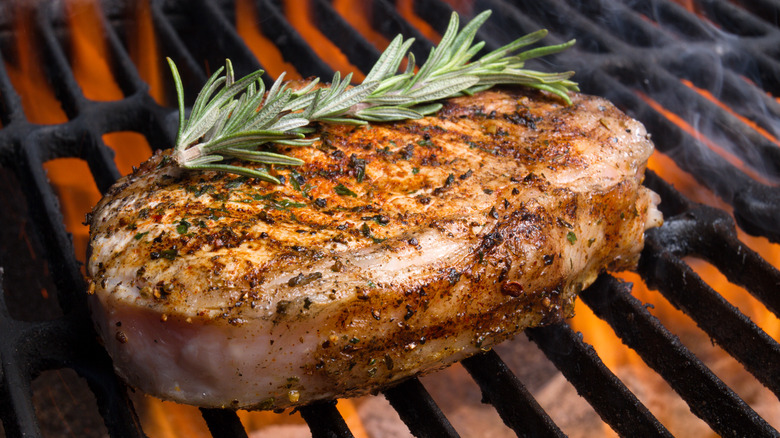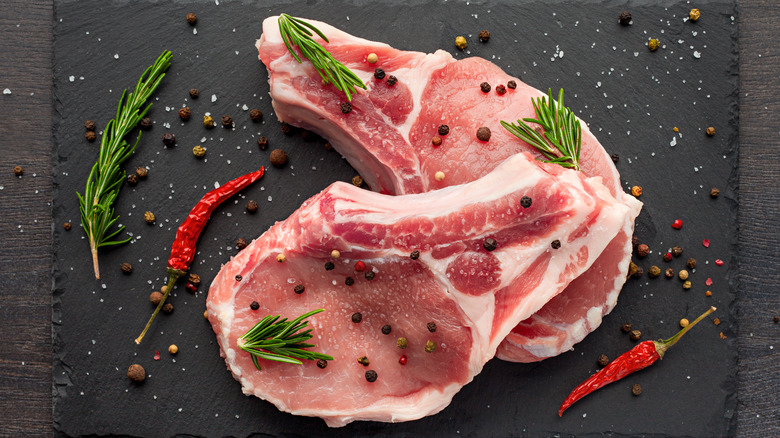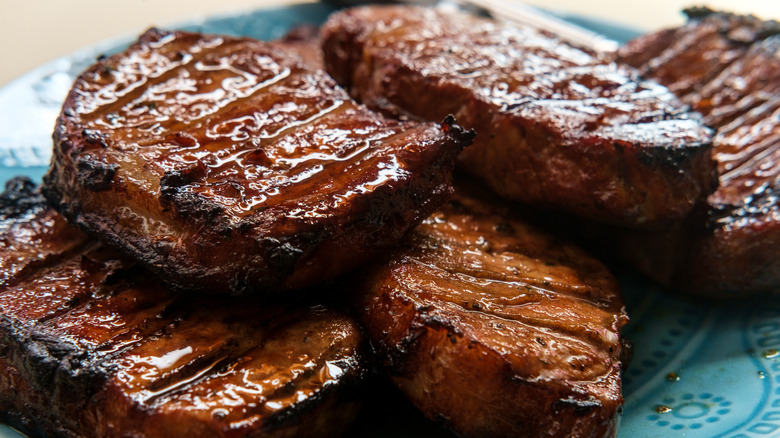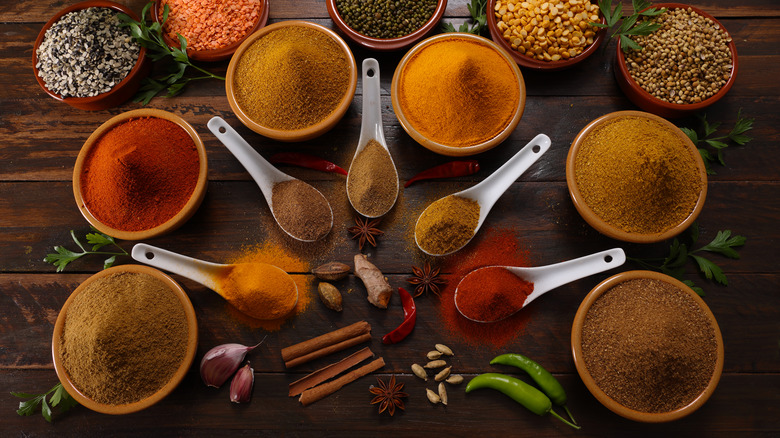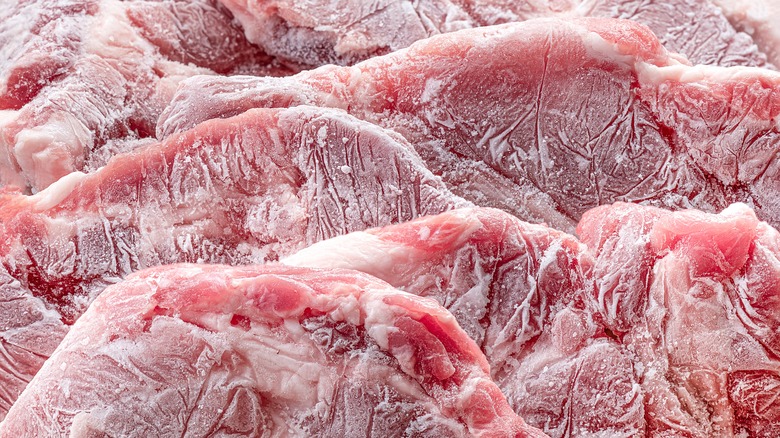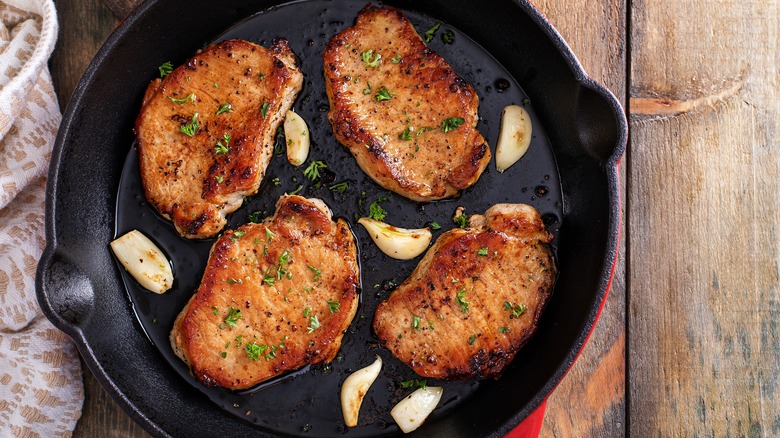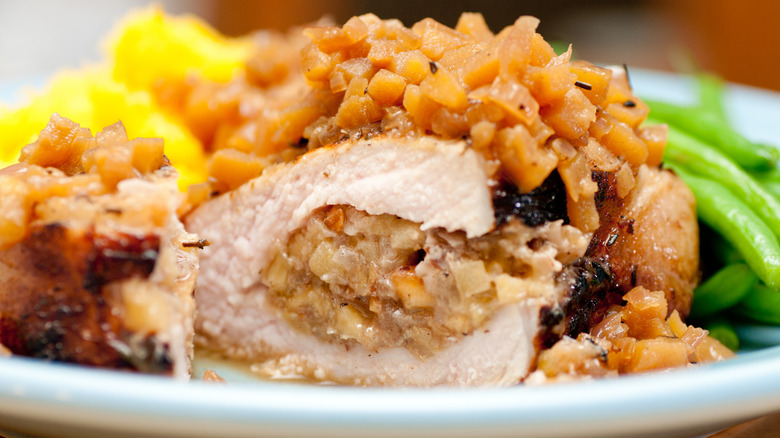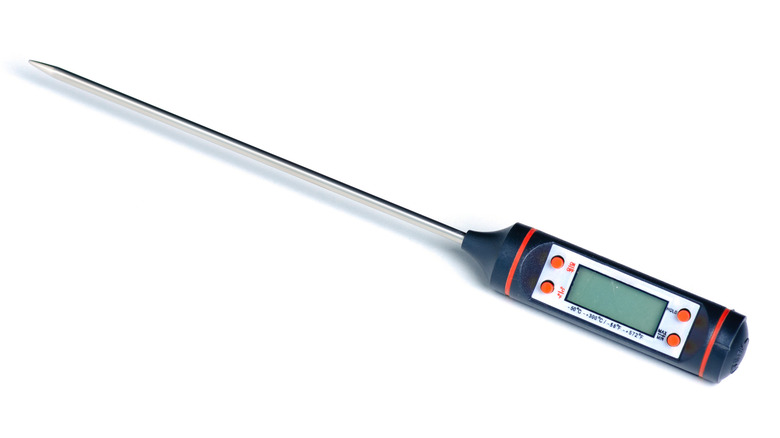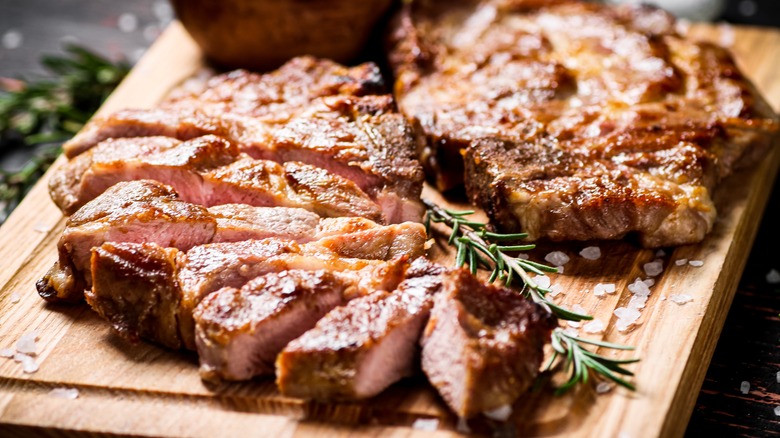8 Common Mistakes People Make When Grilling Pork Chops
Pork chops come with a lot of perks: not only are they easy to prepare and affordable, but an 8 oz. portion can pack in around 36 grams of protein. Pork also contains nutrients such as selenium, zinc, and iron which are associated with a wide range of health benefits that assist with immune function and metabolism. Not only are pork chops nutritious, but they can also be exceptionally delicious — when they're prepared the right way.
As a result of inexperience, attempts to cook pork chops on the grill may end up coming out tough, dry, and chewy. Disappointed with the results, it's tempting to admit defeat and just keep sticking to burgers and hot dogs. But instead of throwing in the towel and eternally banishing pork chops from your rotation, it's important to understand that mistakes are really just opportunities to learn. The good news is that we've come up with a few common problems that might be holding your pork chops back from reaching their full potential. To level up your grill game, read on to check out eight common mistakes that people make when grilling pork chops.
1. Buying the wrong cut of pork
One of the most important variables here is the cut of pork that you're choosing to grill. Just like any other meat, there are plenty of different pork cuts available, and each of them requires particular cooking methods in order to achieve the best results. Pork can have different amounts of fat content and varying thicknesses, depending on the type of cut. If you select cuts of pork that are too thin and lean, then those cuts are more likely to dry out and burn on the grill.
For the grill, I'd recommend choosing thick, bone-in pork chops. Bone-in pork chops have a higher fat content that provides the meat with extra flavor and tenderness. The advantage of choosing thicker pork chops is that they are less likely to get overcooked too quickly — you have more time to cook them, which makes them altogether more forgiving. If you've been strictly using thin and boneless pork chops on the grill, it's time to switch it up and see what you've been missing out on to experience the delicious magic of thicker bone-in chops.
2. Not patting the pork chops dry
One of the secrets to cooking is knowing how to create textural contrast. When the outer skin has a crunchy touch of crispy crust and the middle is still ultra juicy? That's the stuff dreams are made of. You want each bite to reward you with the best of both worlds: the brittle taste of golden brown pork crust along with the lusciousness of perfectly cooked, delicate inner meat. One of the best ways to achieve that textural paradise is actually very easy to do. And it's just a matter of remembering to pat the pork chops dry.
When there is moisture on the surface of pork chops, it's bound to produce steam when it hits the heat. And as you can imagine, steam is very counterproductive when you're trying to achieve a crust. To get that nice crust on the outside of your pork chops, you need to be able to sear them without producing too much steam — which is where patting the outer surface of your pork chops dry comes in. Take a few paper towels and pat the pork chops as dry as you can. This will help the exterior develop more char and crust. Pro-tip: the patting dry method also works well to develop a crust on cuts of steak.
3. Incorrectly seasoning
One common mistake people make is underestimating the importance of seasoning. The right blend of seasoning (along with the correct amount of it) can transform a mediocre meal into a great one. It's fair to say that under-seasoning pork chops will ruin the meal, forcing diners to suffer through flavorless mouthfuls of bland pork. Obviously, the ultimate goal here is to whip up a meal that's a joy to eat and truly tastes pleasurable.
Using a simple blend of salt and pepper works great on steaks and burgers, but don't be afraid to jazz it up some more with your pork chops. Try mixing up an all-purpose rub that's made with salt, black pepper, smoked paprika, brown sugar, onion powder, dried oregano, and garlic powder. If you like a little heat, add a pinch of cayenne powder. Give it a taste and adjust as needed; the rub should achieve an even balance of savory sweetness. The brown sugar in the rub will also help caramelize the pork chops on the grill, which will give them a touch of wonderfully flavorful char.
When you sprinkle on the seasoning, make sure to cover all sides of the pork chops (including the edges). Let the seasoning rest on the pork chops for a few minutes before grilling so that the flavors have time to infuse into the meat.
4. Not letting the pork sit out at room temperature
Many people are reluctant to let raw meat sit out of the fridge for any length of time, fearing that the meat will spoil in a matter of minutes. It's important to keep in mind that there's a huge difference between letting the meat sit out for an hour or so and leaving it on the counter all night long. To be clear: storing raw meat outside of a refrigerator for a long period of time is obviously dangerous and a bad idea. You should always use common sense and safely handle your food. That said, the National Pork Board — which is appointed by the US Secretary of Agriculture — reports that pork can safely sit out of the fridge for up to two hours.
The reason you should let your pork chops rest a bit outside of the fridge before cooking them is so that the internal temperature can rise faster during cooking. When thick pork chops are cooked pretty much straight from the fridge, the center of the meat is still going to be quite cold (which is where the internal temperature should be measured). This means if you're cooking a thick pork chop, the interior is going to cook much slower, the exterior is going to cook much faster, and you're going to end up with a tough, overcooked hunk of meat due to uneven cooking. Instead, let them rest for a little before cooking. Your patience will reward you with more delectable pork chops.
5. Not using a cast iron pan
Cooking pork chops on the grill definitely has its advantages. Namely, being able to impart a smokiness that comes from the flames. At the same time, grilling also has its limitations. Unless you have a flat-top griddle attachment, you're confined to the surface of the grates. While grates are ideal for exposing meat directly to fire, the grates also make it impossible to thoroughly baste your pork chops in any buttery sauces without igniting a potentially treacherous flare-up. The good news is that there's a simple solution to this: a cast iron pan.
Putting a cast iron pan in your grill gives you the best of both worlds: searing and basting the pork chops in the pan, but also cooking directly over the grill to get some subtle char and flame-licked flavor. Having a set-up like this allows you to seamlessly alternate between these two different cooking methods, opening the door to more complex textures and flavors on your pork chops. Try making a compound butter with garlic and herbs to baste your pork chops in the cast iron pan, then let them get some action on the grill grates. Cook them between the grill and cast iron pan until they're finished.
6. Not stuffing the pork chops
Of course, there's nothing wrong with keeping it simple. Pork chops are still delicious even when they're cooked with basic seasonings and glazes. But the truth is that going the extra mile to stuff your pork chops is well worth the time. It's also not as difficult as you might imagine it to be.
The main trick here is making sure that you have thick pork chops so that you have enough room inside to comfortably stuff them. Carefully slice open one side of each chop to create a pocket. When it comes to the actual stuffing, try cooking up a mix of diced fresh peaches, crispy bacon bits, sauteed onions, and minced roasted jalapenos. Add in some salt, black pepper, herbs, breadcrumbs, and a little chicken stock to help bind everything together. Season the pork chops, spoon the stuffing inside of each pocket, sear both sides of the pork chops in a hot pan, and then finish baking them on a tray in the oven. The combination of sweet peaches and smoky bacon inside the pork chops is out of this world, and the hint of roasted jalapenos adds a touch of heat to keep you coming back for more.
7. Overcooking the pork chops
Because consuming undercooked pork can cause sickness related to bacteria and parasites, people tend to be nervous about not cooking it enough. It's important to handle all of your food safely and make sure that you're properly cooking your pork — but it's also possible that being a bit overly cautious is causing you to overcook your pork, resulting in meat that's tough and dry. There's a simple solution here and it's called a digital meat thermometer.
Using a digital meat thermometer will give you a precise reading of the pork chop's internal temperature. According to the USDA, pork chops should be cooked to at least 145 F. Because meat keeps slowly cooking even after it's been removed from the heat — a process known as carryover cooking — you could stop actively cooking the pork at about 135 F, and the residual heat should be enough to nudge the pork's internal temperature up an extra 10 degrees. Just make sure that you end up hitting 145 F and you're good to go. Being more mindful of internal temperature will help you avoid overcooking your pork chops and make them more tender.
8. Not letting the meat rest
Here's the moment you've been waiting for. You've put in the time and effort to make some delicious pork chops. They're fresh off the grill, glistening in all their flavorful glory, practically begging for you to immediately slice into them. But that animalistic impulse inside of you to wolfishly dig in needs to be momentarily resisted at all costs.
If you give the meat time to rest — only somewhere between five to 10 minutes — the juices in the muscle fibers will stay more contained. This resting period allows those juices to immerse throughout the meat, creating pork chops that are ultra tender. But if you jump the gun and cut into the pork chops too soon before the meat has a chance to fully rest, those flavorful juices will spill out, robbing the cut of its true potential for exquisite succulence. Once again, this is another moment in life where a little patience goes a long way.
